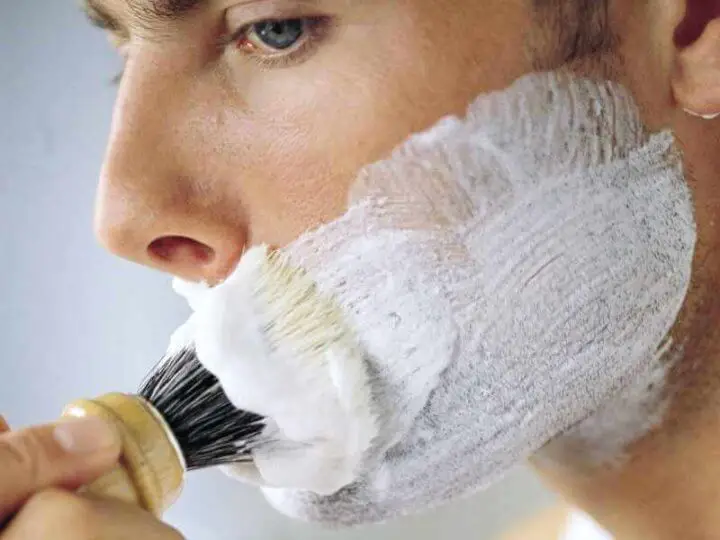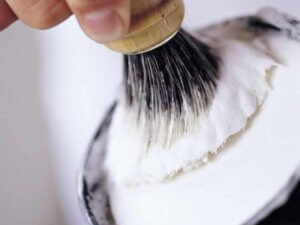
There’s a key detail that’s often overlooked in lathering shaving cream with a brush discussions. But it’s critical to getting a great shave.
The Argument
Every now and then I see arguments about lathering shaving cream or soap–generally after seeing someone on Youtube doing it badly. The observations usually boil down to “there’s not enough water in the lather!” Followed by helpful (!) advice about how to lather “correctly.” Let’s look at some of the suggested brush lathering shaving cream techniques.
“Classic” Lathering Technique

Most commonly a brush loading-and-lathering technique generally runs along these lines:
- Fill a sink with warm-to-hot water and place the shaving brush in the sink. How long the brush needs to be soaked is dependent on the type of brush.
- After soaking shake the brush three or four times to get rid of the excess.
- If you have a shave soap puck or a jar of shave cream, spin the brush onto it, pressing down slightly, to coat the brush’s bristles with product (an alternative for the jar is to scoop some out with a small utensil and place it directly into the center of the brush). You are looking for more than just a light foam on the bristles–you want a relatively thick coat. If you are using a tube of shave cream, squeeze out an almond-size amount directly into the center of the brush.
- Start massage the brush into the bowl or on the face using circular motions and pressing the brush down slightly. Some advocate using a painting motion vs. a circular motion but let’s start off with circular. Massage for about 30 seconds then dip the tips of the brush in water and repeat. It may take a several minutes for the lather to build on the brush to the right consistency, depending on the type of brush, the type of product used, and the mineral content of the water. Whether you’re building in a bowl or to the face, you are looking for a shiny, somewhat “loose” consistency (runnier than what might come out of a can or brushless tube) with soft “peaks” (like a cake batter) without any bubbles.
Brush Priming (“Superlather”)
“Priming” a shaving brush, also known as making a “superlather,” involves an initial load with a soap and a very wet brush, followed by adding a small amount of lathering shaving cream before completing lathering in the “classic” way.
“Marco Method” Lathering
When shave enthusiasts really get going on a discussion about brush lathering, comments about the “Marco Method” usually appear. Sometimes considered a near-myth by newcomers because it can be kind of hard to find recent authoritative information on the details, the “Marco Method” first appeared about 20 years ago. Paraphrased:
- Soak the brush for at least 30 seconds.
- Turn the brush upside-down without shaking it. Allow water to drain by gravity only (no shaking): the brush has to be kept full of water.
- Start loading the soap with swirling motions. Work slowly, without pressure on the brush. Remember that it should be very wet.
- Continue to load the brush for 45-60 seconds, making 100-120 swirls. Loading time is dependent on the size of the brush and how much water it can retain.
- Move the brush to the face and begin lather to the. Again, there will be a LOT of lather: it may get messy.
- While face lathering slowly and progressively add, a few drops of water to the tips of the brush.
- Continue to lather until it is the right consistency.
Quoted from the original entry: “The main concept to always keep in mind is simple: a lot of water + a lot of swirls + a lot of soap = a lot of great, thick, slick and effective lather. This lathering technique works very well even with hard, triple milled soaps. Exactly as described above, with the sole exception that I soften the surface of hard soaps with a dozen drops of water before starting to make swirls.”
“Perfect” Lathering

In 2019 I came up with my own method of building lather with a brush, the “Perfect” method. Summarized:
- Soak the shave brush in water. Start with a one minute soak and adjust accordingly.
- After soaking grab the brush by its handle, hold it inverted with one hand (hair down, handle up) and with your other hand circle the hair with your thumb and forefinger like you’re signaling “that’s perfect,” and gently give it a squeeze. Where you do this on the brush depends on the type of brush: most brushes should be squeezed nearer the tips; badger brushes or other brushes with a relatively long “loft” may need to be squeezed a bit further down down toward the handle (but no more than the middle of the loft).
- Return the brush to the upright position (handle down, tips up). If you’re loading the brush from a squeeze tube of shave cream, plop an almond-sized amount slightly into the brush. If you’re loading from a tub of shave soap or cream, spin the brush into the tub (pressing down slightly) holding the tub upside down, to load the brush.
- I suggest finish building lather in a bowl or mug, at least initially, even if you’re normally a face latherer. I think it’s easier to determine if there is still too much water: you can drain the “slop” out of the bowl and continue lathering.
The Lathering Concept Detail That Many Shavers Miss
All these techniques boil down to one thing: water in the brush. But it’s not so much how much water is in the brush as much as where the water is in the brush.
The most efficient, effective mixing of water and shave product (hydration) to create lather occurs in an area near the bottom of the brush knot sometimes referred to as the breech (hat tip to “Method Shaving” adherents, as is the idea of brush priming above–though it’s done a little differently).

The rest of the brush can be sopping wet, but if the breech is relatively dry (from, say, aggressively shaking the brush or mashing the brush all the way down onto the skin) the resulting lather will not be ideal. Consider: ever done a lather for your first pass and set the brush down on on its handle (hair/fiber pointing up), then notice the lather is better for successive passes? Water and shave product have “percolated” through the breech by then.
Brush priming is essentially getting more water to stay in the breech with a “sticky” soap foam.
“Marco Method” lathering provides a better lather (when done correctly) simply because it overwhelms the brush (including the breech) with lots and lots of soap/cream and water–wasting both.
“Perfect” lather provides a better lather (when done correctly) because it allows much less water to drain from the breech, providing a better mixing action for proper hydration.
Conclusion
Old school lathering shave creams and soaps need water and shave brush to mix into a proper lather. But the lather best mixes deep inside the brush. If the water isn’t there, either by shaking the water out of it or by opening up the brush loft too much, the lather won’t be as good as it could be.

Nice article, Mark. The method you have advocated is very similar to what I have been doing for many years.
I dip my brush in water for at most a minute and then give it a gentle shake or two to eliminate any excessive water. My brush is usually wet enough so that I rarely have to add extra water. I then load my brush the length of time depends on the hardness of the soap. A hard soap takes a little longer but softer soaps or creams load much faster. I then make lather in a bowl. If I need to add water to the mix I dip my fingers in water and sprinkle the soap.
When I first started shaving I used a mug then I went to face lathering. But, for the past year, I have gone back to bowl lathering. I also spend more time making the lather when I bowl lather.
Very nice article 🙂
Lots of lather, in a fast way, with a lot of hydration:
https://youtu.be/KBSCRqm0bHA
Hi Mark
Excellent article, tried it today and the result was amazing. Great lather that helped me get a great shave.
Thanks as always
Thank you for the great article. Very interesting and informative.
Good post Mark. You are more of a scientist than a wet shaver I believe.
I also believe that Marco Method is like go fishing with TNT. Does not help develop a good lathering technique and you just swirl a dripping wet brush around.
I strongly suggest your lathering method with some differences:
1. I never touch the wet knot, just shake it to be just damp.
2. Using a dollop size amount of cream leaves me out of lather in the later passes and never gets dense even with less water. So I use two or three times more product.
This article is interesting and gives us tips on better methods. At the same time I have to say (my own opinion) that after reading blogs and watching videos on wet shaving I really do think we make shaving too complicated. I enjoy picking out a brush, soap, bowl and razor and just going to the sink and shaving without really thinking about it.
All great tips. Very similar to my usual brush prep routine. I soak my brush in hot water in a shaving bowl while I shower. If I’m shaving with a hard soap in a container, I also soak (bloom) it with water while I shower. I find this helps transition the soap from something firm and hard to something more easily absorbed by my brush. I also DO NOT soak my brush in a sink full of water. I think doing this runs the risk of degrading the adhesive that attaches the knot to the handle. Also, I swirl with circle motions on my face during the first pass which seems to volumize the lather more than just “painting” it like you described. Once most of my beard stubble is reduced I will “paint” my face with lather on subsequent passes.
Good read. Thank you. Good lather should have the consistency of a meringue, somewhat light, and no bubbles.
KD
Great article. I never knew about the “breech” area of the brush and its resulting effect on lathering. Going to try it today. Thanks for the info!
Interesting read that makes sense to me! I normally get what I consider good lather, but I am going to try your method in tomorrow’s shave! Thanks for the tip.
Comments are closed.